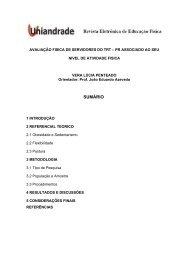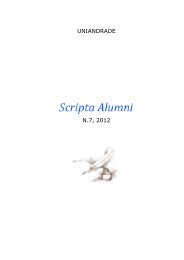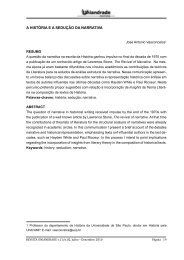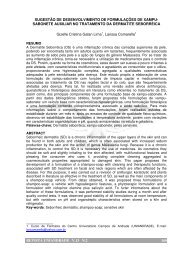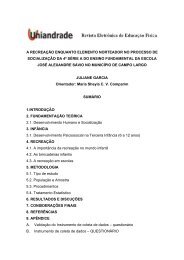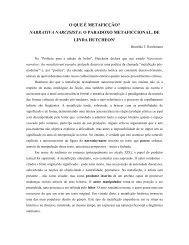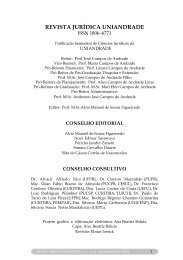Scripta 9_2_link_final.pdf - Uniandrade
Scripta 9_2_link_final.pdf - Uniandrade
Scripta 9_2_link_final.pdf - Uniandrade
You also want an ePaper? Increase the reach of your titles
YUMPU automatically turns print PDFs into web optimized ePapers that Google loves.
task attracts the painter’s attention. The painter and his wife, Catharina, need<br />
a maid to clean the master’s studio. Griet needs a job because her father, a<br />
tile artisan, has just lost his sight in a work accident and cannot support his<br />
family anymore. The Vermeers are there to settle the <strong>final</strong> details of her<br />
hiring. After Griet starts working in their house, Vermeer slowly draws her<br />
into the world of his paintings: the still, luminous images of solitary women<br />
in domestic settings. A bond between maid and master is formed as she<br />
becomes responsible for cleaning his studio – a place so private that not<br />
even his wife is allowed to enter. On the verge of womanhood, Griet also<br />
contends with the attentions both from the butcher’s son, Pieter, and from<br />
Vermeer’s patron, van Ruijven. She has to find her way through this new<br />
and strange life outside the loving Protestant family she grew up in, now<br />
fragmented by accident and death, as her father becomes blind as mentioned<br />
above, her sister dies of the plague and her brother moves to another town<br />
to find work.<br />
The growing intimacy between master and maid creates disruption<br />
and jealousy. At first, Griet describes the artworks to her father, who has<br />
always been a great admirer of the master’s work, when visiting her family<br />
over the weekends. Griet leaves her maid status behind when elevated to<br />
master’s assistant by helping him with the preparation of the colors by<br />
mixing pigments and they start discussing his art pieces as he finishes a<br />
painting and starts a new one. Van Ruijven gets interested in Griet since the<br />
very first time he sees her. He is determined to have the wide-eyed maid, as<br />
he likes to call her. Besides van Ruijven, no one else agrees with Griet’s<br />
modeling, because of rumors involving the maid who last did so for the<br />
painting The Girl with a Wine Glass and became pregnant even before the<br />
painting was finished. Van Ruijven’s obsession leads to the climax of the<br />
story when Griet becomes Vermeer’s muse, culminating in her sitting for<br />
the portrait Girl with a Pearl Earring. The novel can be considered a<br />
Künstlerroman because the core of its narrative is built on Vermeer’s real life<br />
and the story of the mysterious girl he painted. The literary work is enriched<br />
by borrowing elements from painting shown by ekphrastic descriptions<br />
through Griet’s reading of Vermeer’s work.<br />
Chevalier makes vast use of descriptions of Vermeer’s paintings in<br />
the narrative of the novel Girl with a Pearl Earring, which is named after the<br />
portrait. Griet, the female protagonist, lays out the core of the story through<br />
a series of descriptions. This ancient descriptive device, which became<br />
rather popular during the Romantic Movement in the nineteenth century, is<br />
<strong>Scripta</strong> <strong>Uniandrade</strong>, v. 9, n. 2, jul.-dez. 2011 13






